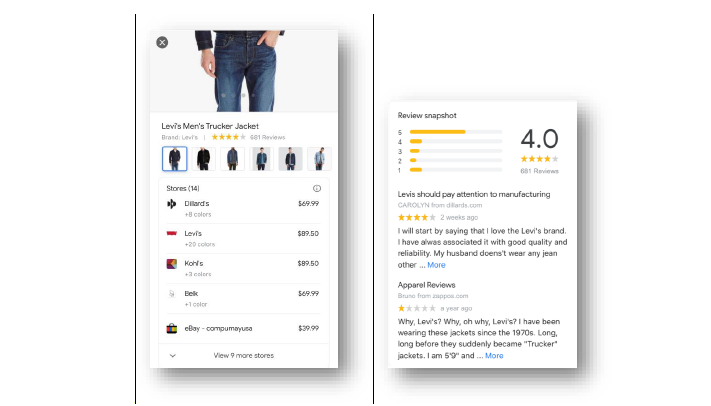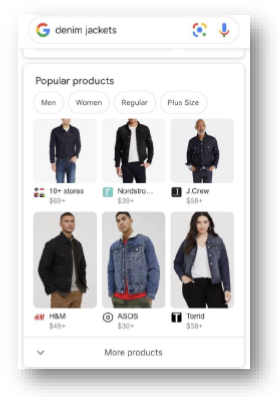Google Rolls Out Organic ‘Popular Products’ Listings In Mobile SERPS

Google has announced a new feature that is now live within organic mobile search results for retail and product-related searches.
Similar to shopping ads, the new ‘Popular Products’ section highlights various products when doing category and product-related searches, such as ‘denim jackets’ and ‘Converse Chuck Taylors.’
This section includes a product grid of six products (which can be expanded when a searcher clicks on ‘More Products’), and filters, such as style, department, and size type.
Here’s everything we know about Google’s mobile Popular Products feature and how it will impact advertisers, SEO, and vertical-specific brands.
The new ‘Popular Products’ feature is a pretty cool way in the way it combines SEO elements like clean product & review structured data & buttoned-up canonical tags with products from the Merchant Center feed to enable automatic item updates.

— Kali Wyrosdic, SEO Specialist at Tinuiti
Upon clicking on a specific product, searchers are taking to a listing of that product that includes:

Searchers that click on a specific retailer link are taken directly to the product detail page (PDP) for that product.
To prepare for this new search feature, retailers should ensure that the Product schema markup found on PDPs includes the required/recommended properties and does not render any warnings or errors when validating the markup in the Structured Data Testing Tool.
Additionally, retailers should ensure that their products are included in their Merchant Center product feed and follow Google’s best practices.
The rollout of this search feature represents a new opportunity for retail brands to drive more mobile organic search traffic to specific PDPs for relevant product and category searches.
Appearing within the ‘Popular Products’ section allows brands more organic opportunities, in addition to the typical organic results that appear for these searches.
Currently, there is no set position within the SERPs for this section. In testing for various product/category, the ‘Popular Products’ section can appear above normal organic listings, in the middle of results, or at the bottom of the SERPs.

It is worth noting that this section is now going to be among an increasingly crowded mobile SERP that includes: shopping ads, text ads, organic results, image/video results, local map results, and other results. Brands should monitor mobile traffic across organic search, paid search, and shopping ads to determine if this new section has any impact on their visibility within the mobile SERPs.
Google’s new Popular Products section is yet another example of how product data feeds and the metadata attributes associated with products are becoming more important across both paid and organic channels. We expect retailers with clean structured data (and teams to optimize and manage this data) to have a leg up on showing products for this new format.

— Mike Wojciechowski, Senior Director of Shopping & Feed at Tinuiti
Retail brands that sell products that can be found at different retailers (such as Nike sneakers or Levi’s jeans) should be aware of their organic competition within this section and should be mindful of how the listed prices of other retailers, as well as the aggregated reviews, may influence which retailer links searchers click on.
Searchers may be enticed to click on the retailer link with the cheapest price or may avoid the product entirely if they see negative reviews from various retailers.
As previously mentioned, the rollout of this new section within mobile SERPs represents more organic opportunities for retail brands hoping to have a presence for relevant product and category related terms.
Prior to this being rolled out, organic search opportunities for product/category terms were the typical organic results and were limited by the presence of both paid search text ads and shopping ads that were shown more prominently. As searchers become more accustomed to seeing this ‘Popular Products’ section, we may see more mobile organic search traffic to PDPs.
Given that this section is influenced by Product schema markup and Merchant Center product feeds, SEO and shopping ads teams should work more closely together to ensure that their brands are well-positioned for this new section and do not have any issues within the schema markup or shopping feeds.
SEO, shopping ads, and paid search teams should closely monitor mobile traffic for their specific channels if they have a presence for these relevant keywords.
It has not yet been announced how webmasters can successfully measure organic search clicks/impressions from the ‘Popular Products’ section versus organic search clicks/impressions from typical organic results, but it is possible that Google will update the ‘Product Results’ section of Google Search Console’s Performance report to highlight search traffic from ‘Popular Products’.
Since this update is very specific to the retail industry, retail brands that are aiming to appear for relevant product/category searches will be the most heavily impacted.
As previously mentioned, retail brands should be mindful of this feature’s impact on mobile search traffic across organic search, paid search, and shopping ads if they currently appear for relevant product/category search terms.
Retail brands should prioritize any potential site work to improve their Product schema markup or Merchant Center product feeds to ensure there are no issues or missing opportunities to enhance.
There’s big opportunity for SEO, shopping, and paid search teams to work together to own this hybrid space in organic search for e-commerce brands. Having strong product pages, high-quality images and positive reviews across the web continue to play an important role.

— Kali Wyrosdic, SEO Specialist at Tinuiti
“Plus, Google says it will use a site’s metadata for these types of results regardless of a brand opting-in, so put your best foot forward or get left behind! Don’t have a Merchant Center feed? No problem – clean up your product structured data markup and you’ll increase your chances of surfacing in this and other free results across Google surfaces.”
